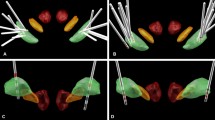Abstract.
The effect of stimulation frequency for pallidal deep brain stimulation in five patients with either generalized or segmental dystonia was evaluated three to twelve months postoperatively via a randomized, double-blind paradigm. The quality of life and the severity of dystonic symptoms improved by approximately 60% and 43% respectively using a frequency of 130 Hz. Compared with 130 Hz a significant further clinical improvement was observed at frequencies of 180 and 250 Hz, which contrasted with a significant deterioration at lower frequencies (5, 50 Hz) compared to 130 Hz.
Similar content being viewed by others
Author information
Authors and Affiliations
Corresponding author
Rights and permissions
About this article
Cite this article
Kupsch, A., Klaffke, S., Kühn, A.A. et al. The effects of frequency in pallidal deep brain stimulation for primary dystonia. J Neurol 250, 1201–1205 (2003). https://doi.org/10.1007/s00415-003-0179-0
Received:
Revised:
Accepted:
Issue Date:
DOI: https://doi.org/10.1007/s00415-003-0179-0




